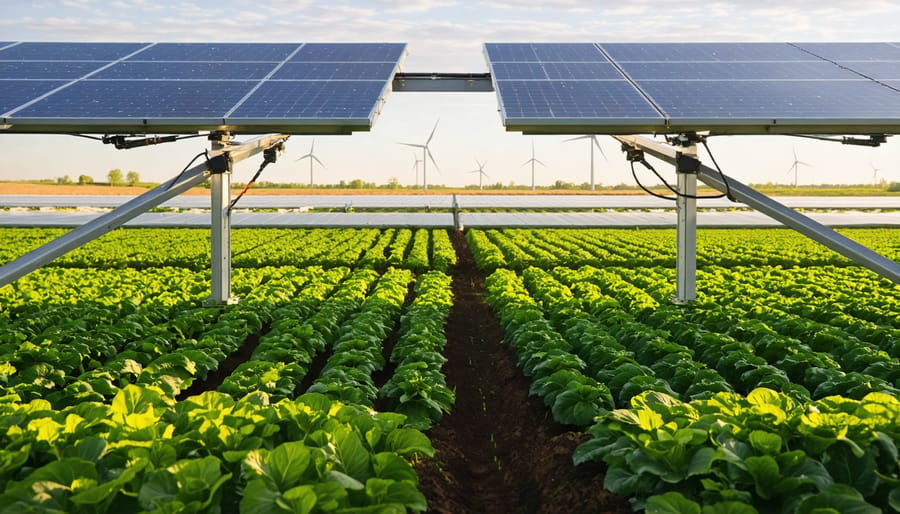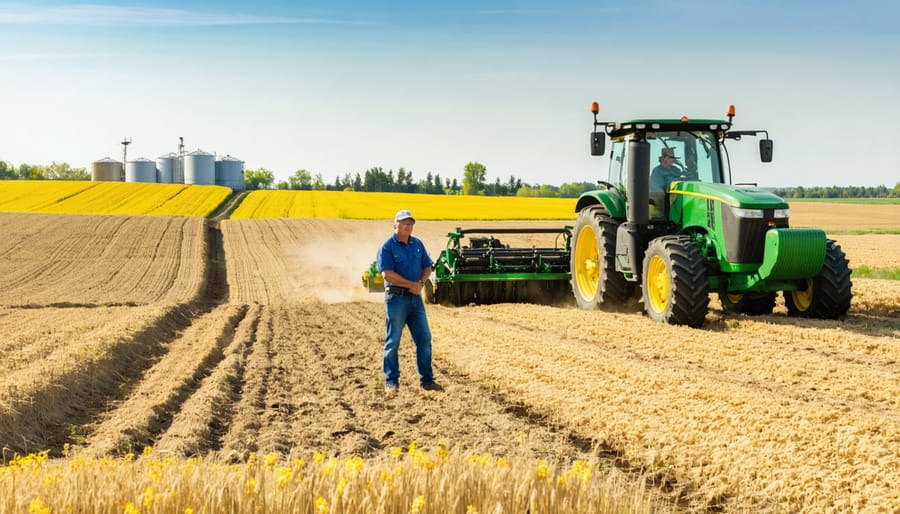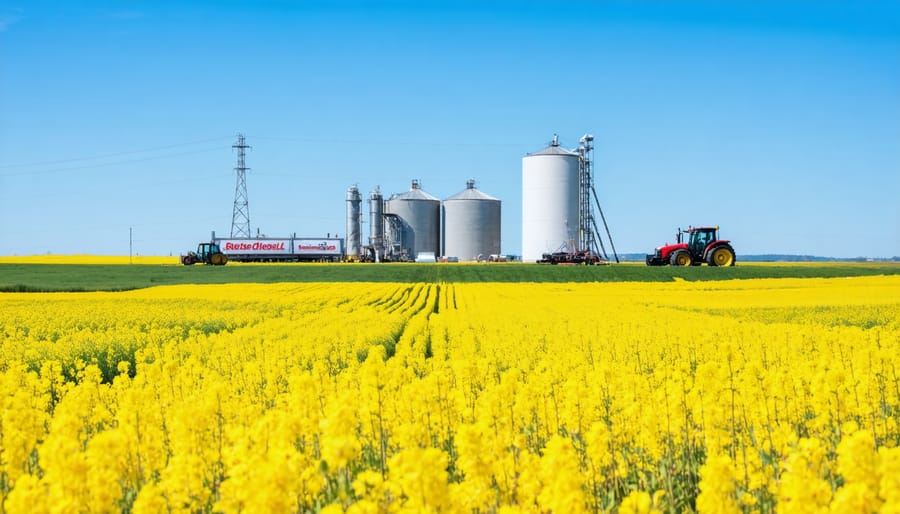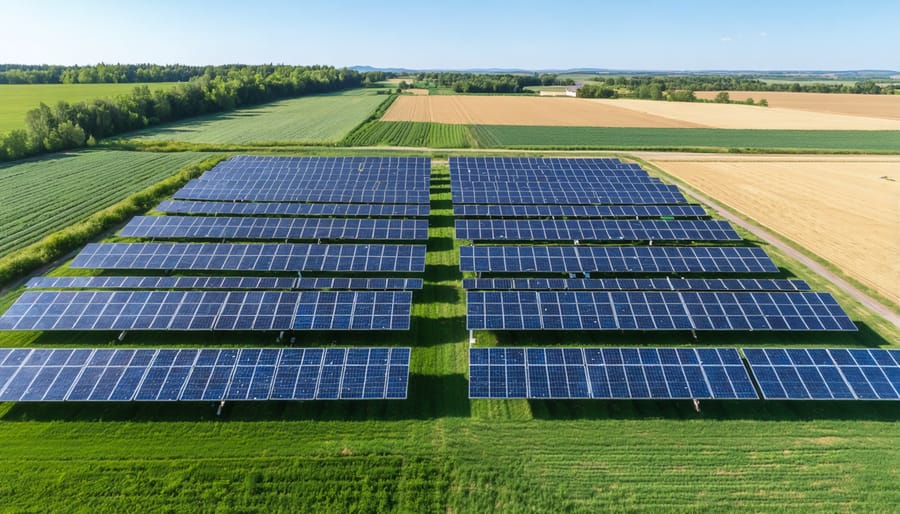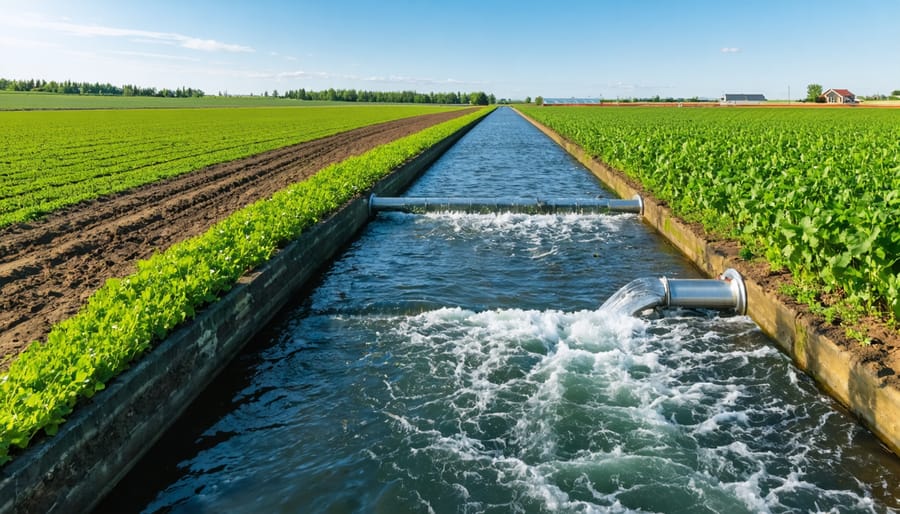Beneath the surface of Canada’s waters lies a complex network of life that powers our agricultural future. From the pristine mountain streams of Alberta to the productive wetlands of the Prairie provinces, aquatic ecosystems serve as natural powerhouses for sustainable farming practices. These dynamic systems – where water, plants, and organisms interact in perfect balance – offer innovative solutions for modern agricultural challenges.
Aquatic ecosystems provide essential services that directly benefit Canadian farmers: natural water filtration, nutrient cycling, and climate resilience. In Alberta alone, these systems contribute over $4 billion annually to the agricultural economy through irrigation, natural pest control, and soil enrichment. For farmers seeking to enhance their land’s productivity while maintaining environmental stewardship, understanding and protecting these vital water systems has become increasingly crucial.
As climate patterns shift and water resources become more precious, Canadian agricultural communities are turning to aquatic ecosystem management as a cornerstone of sustainable farming. By integrating these natural systems into modern agricultural practices, farmers can reduce input costs, improve water efficiency, and build more resilient operations for future generations.
[Word count: 143]
Understanding Aquatic Ecosystems in Agricultural Energy Systems
Natural Water Systems as Energy Sources
Natural water systems offer incredible potential for sustainable energy generation on Canadian farms. Many Alberta farmers are already harnessing the power of flowing water through small-scale hydro power systems, converting natural water movement into clean electricity.
Streams, rivers, and irrigation channels can provide consistent energy year-round, especially during spring runoff when water flow is strongest. A typical farm stream dropping just 2 metres can generate enough power to run essential farm operations, reducing reliance on grid electricity.
Here in Alberta, farmers are particularly well-positioned to benefit from water-based energy systems thanks to our extensive irrigation networks and natural waterways. These systems work well alongside existing agricultural operations, requiring minimal maintenance while providing reliable power generation.
The beauty of natural water systems lies in their dual purpose – they continue supporting local ecosystems while generating clean energy. Fish passages and careful flow management ensure wildlife remains protected while farms benefit from renewable power generation.
Constructed Aquatic Systems for Energy Production
In Alberta’s agricultural landscape, constructed aquatic systems are emerging as innovative solutions for energy production. These purpose-built water systems combine traditional farming practices with renewable energy generation, creating efficient closed-loop systems that benefit both the environment and farm operations.
A prime example is the integrated aquaculture-hydro system at the Henderson Family Farm near Red Deer, where a series of tiered ponds generates approximately 5 kW of power through micro-hydro turbines while supporting fish cultivation. The system’s design maximizes water use efficiency by incorporating gravity-fed flows and strategic elevation changes.
These systems typically consist of interconnected ponds, channels, and wetlands that serve multiple purposes. Beyond energy generation, they provide irrigation, help manage stormwater, and create wildlife habitats. Many Alberta farmers have found success with solar-powered pumping systems that circulate water through these constructed ecosystems, reducing grid dependency while maintaining optimal water flow.
Local agricultural extension services offer support for farmers interested in implementing these systems, with grants available through the Canadian Agricultural Partnership for sustainable energy initiatives.
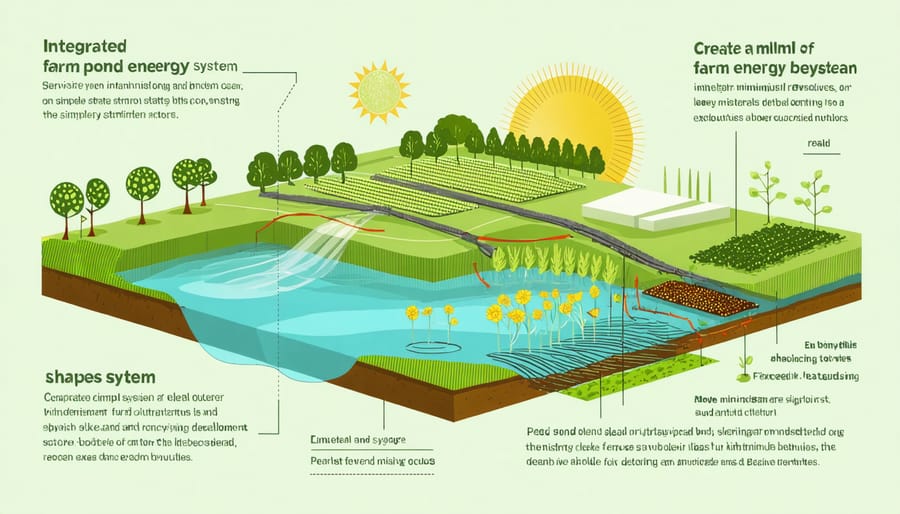
Alberta Success Stories: Aquatic Energy Systems in Action
Micro-Hydro Systems in Mountain Regions
In Alberta’s mountainous regions, farmers are increasingly turning to micro-hydro power as a sustainable energy solution. Recent micro-hydro installations in Alberta have shown promising results, particularly in areas with year-round flowing creeks and significant elevation changes.
Take the example of the Mountain View Farm near Canmore, where a 5-kilowatt system harnesses the power of a mountain stream dropping 30 metres in elevation. This installation provides enough electricity to power the farm’s main operations while maintaining the creek’s ecological balance. The system’s intake design includes fish screens and maintains minimum flow requirements, ensuring minimal impact on local aquatic life.
Similar success stories can be found in the Bow Valley region, where several family farms have implemented micro-hydro systems ranging from 2 to 10 kilowatts. These systems typically cost between $15,000 and $40,000 to install, with many farmers reporting full cost recovery within 5-7 years through reduced energy bills.
What makes these mountain-based systems particularly effective is their reliability throughout the year. Unlike prairie waterways that may freeze completely, many mountain streams maintain consistent flow even during winter months, thanks to groundwater sources and glacial melt. This ensures steady power generation while preserving the delicate balance of local aquatic ecosystems.
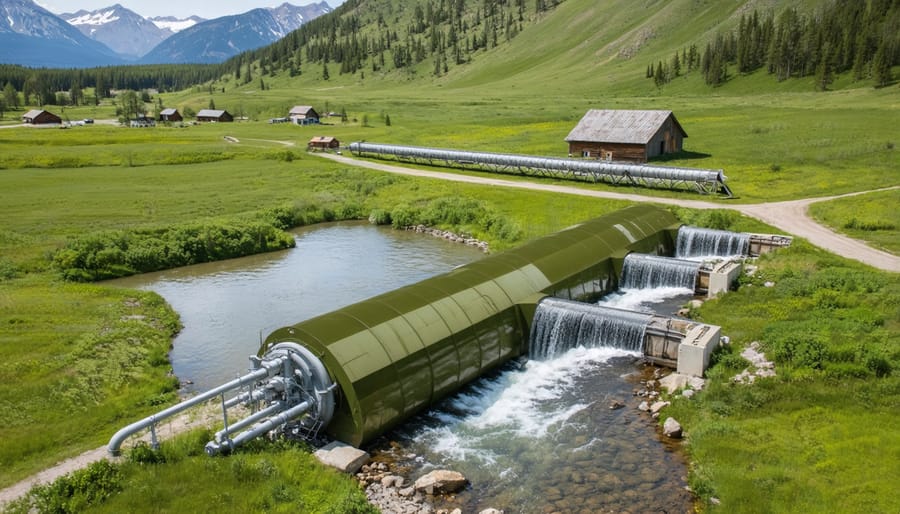
Integrated Pond Systems for Multiple Benefits
The Thompson family farm in Lacombe County demonstrates how integrated pond systems can deliver multiple benefits to agricultural operations. Their 2-hectare pond system, established in 2018, serves as both an irrigation source and a habitat for native species while contributing to their farm’s sustainability goals.
“We’ve seen a 30% reduction in our irrigation costs since implementing the pond system,” shares Sarah Thompson. “Plus, the ecosystem services have been remarkable – from natural pest control to improved pollination of our crops.”
In Southern Alberta, the Martinez Ranch utilizes a series of three interconnected ponds totalling 4 hectares. The system provides year-round water storage, supports their cattle operation, and generates energy through a small-scale hydroelectric setup that powers their farm buildings. The ponds also act as natural filters, improving water quality before it returns to local waterways.
The Wetaskiwin Agricultural Co-op’s demonstration site showcases how farmers can integrate aquaculture into their pond systems. Their model combines rainbow trout farming with water storage, generating an additional revenue stream while maintaining water quality through biological filtration.
These success stories highlight the versatility of integrated pond systems. Key benefits include:
– Reliable water storage for irrigation
– Energy generation potential
– Enhanced biodiversity
– Natural water filtration
– Additional income opportunities
– Improved farm resilience
When properly designed, these systems can pay for themselves within 3-5 years through reduced operational costs and diversified income streams.
Environmental Benefits and Ecosystem Services
Carbon Footprint Reduction
Aquatic ecosystems in agriculture play a significant role in reducing carbon emissions through multiple pathways. Based on recent studies from the University of Alberta, integrated aquatic systems can sequester up to 2.5 tonnes of carbon per hectare annually. This is particularly impressive when compared to traditional farming methods.
In the Calgary region, farmers implementing these systems have reported a 30% reduction in their overall carbon footprint. The water bodies act as natural carbon sinks, while aquatic plants efficiently capture CO2 during photosynthesis. Additionally, these systems reduce the need for carbon-intensive practices like frequent tilling and mechanical aeration.
The data from Alberta’s Agricultural Carbon Assessment Program shows that farms using aquatic ecosystems decrease their fossil fuel consumption by approximately 40% through reduced machinery use. The natural filtration and water circulation processes eliminate the need for energy-intensive water treatment systems.
Perhaps most importantly, these systems help build soil organic carbon. Nutrient-rich water from aquatic systems, when used for irrigation, enhances soil carbon storage capacity by up to 25% compared to conventional irrigation methods. This translates to roughly 1.8 tonnes of additional carbon sequestered per hectare each year in surrounding agricultural lands.
Biodiversity Enhancement
Integrating aquatic ecosystems into your agricultural landscape creates thriving habitats that support a diverse range of wildlife. When properly managed, these systems become sanctuaries for native species while complementing regenerative farming practices. In Alberta, farmers have reported increased sightings of waterfowl, beneficial insects, and amphibians within months of establishing these ecosystems.
Local success stories include the Marshall family farm near Red Deer, where the introduction of a managed pond system attracted over 15 bird species and established a healthy population of beneficial predatory insects that naturally control crop pests. The surrounding vegetation provides shelter for pollinators, contributing to improved crop yields in adjacent fields.
These ecosystems also support endangered species recovery. The northern leopard frog, a species at risk in Alberta, has shown promising population growth in agricultural areas with well-maintained aquatic habitats. By incorporating native aquatic plants and maintaining buffer zones around water features, farmers create essential corridors for wildlife movement and breeding grounds for beneficial species.
Remember, every new habitat feature you add contributes to the overall health of your farm’s ecosystem, making your operation more resilient and sustainable.

Implementation Guidelines for Canadian Farmers
Site Assessment and Planning
Before implementing an aquatic ecosystem on your farm, a thorough site assessment is crucial for success. Start by evaluating your water resources, including natural bodies of water, groundwater availability, and annual precipitation patterns. In Alberta, where water access can vary significantly by region, understanding your water rights and local regulations is essential.
Consider your land’s topography and soil composition, as these factors influence water retention and flow. Ideal sites typically have gentle slopes (1-5%) and clay or loam soils that can support pond construction. Document existing wildlife patterns and vegetation, as these elements will integrate with your new ecosystem.
Energy potential assessment is another critical factor. Calculate your farm’s current energy needs and evaluate how smart grid integration could optimize your system’s efficiency. Consider seasonal variations in energy demand and how they align with aquatic energy production cycles.
Develop a detailed site plan that includes:
– Water source locations and access points
– Proposed system layout and infrastructure
– Buffer zones for environmental protection
– Construction staging areas
– Maintenance access routes
Consult with local agricultural extension services and experienced aquaculture professionals during the planning phase. They can provide valuable insights about regional success stories and potential challenges specific to your area. Remember to factor in future expansion possibilities and climate resilience in your planning process.
Regulatory Compliance and Support
In Canada, aquatic ecosystem management is governed by several key regulations, including the Fisheries Act and the Canadian Environmental Protection Act. Alberta farmers should particularly note the Water Act and Environmental Protection and Enhancement Act, which directly impact agricultural water usage and ecosystem management.
The Department of Fisheries and Oceans Canada (DFO) offers guidance and support for maintaining healthy aquatic ecosystems on agricultural lands. Farmers can access resources through the Canadian Agricultural Partnership (CAP), which provides funding for environmental stewardship initiatives, including aquatic habitat preservation and water quality improvement projects.
In Alberta, the Environmental Farm Plan (EFP) program helps producers assess their environmental risks and develop management strategies. Through this program, farmers can access technical support and potential funding for implementing aquatic ecosystem protection measures.
Local watershed stewardship groups and agricultural fieldmen are valuable resources for guidance on compliance and best practices. The Agricultural Service Board offers free consultations to help farmers navigate regulatory requirements while maintaining productive operations.
For specific projects, the Alberta Water Management Program provides cost-sharing opportunities, supporting farmers in implementing sustainable water management practices that benefit both agricultural operations and local aquatic ecosystems.
Maintenance and Long-term Management
Regular maintenance is essential for keeping your aquatic ecosystem healthy and productive. Start with weekly water quality testing, checking parameters like pH, temperature, and dissolved oxygen levels. In Alberta’s climate, seasonal adjustments are particularly important – many farmers find success by increasing monitoring frequency during extreme weather changes.
Create a maintenance calendar that aligns with your farm’s operational schedule. Include tasks like filter cleaning, pump maintenance, and plant trimming. Most Alberta farmers schedule major system cleanouts during the slower winter months, typically dedicating about 4-6 hours per month for routine maintenance.
Long-term management involves continuous learning and system optimization. Keep detailed records of water quality readings, maintenance activities, and any challenges encountered. This data helps identify patterns and improve system efficiency over time. Consider joining local agricultural networks – many Alberta farmers share valuable insights about managing aquatic ecosystems through community workshops and mentorship programs.
For system optimization, focus on energy efficiency and resource conservation. Install timers for pumps and lighting systems, and consider incorporating renewable energy sources. Remember to maintain backup systems and emergency protocols, especially important during our harsh prairie winters.
Throughout this exploration of aquatic ecosystems in agricultural settings, we’ve seen how these dynamic systems can transform our farming practices while supporting environmental sustainability. From water conservation to enhanced biodiversity, the benefits of integrating aquatic ecosystems into our agricultural operations are both practical and far-reaching.
Here in Alberta, we’re uniquely positioned to become leaders in sustainable agriculture through the implementation of these systems. Our diverse landscape and strong farming community provide the perfect foundation for innovation in this field. The success stories we’ve shared from local farmers demonstrate that these aren’t just theoretical concepts – they’re proven solutions that work in our climate and conditions.
Remember, starting small is perfectly acceptable. Whether it’s creating a simple retention pond or developing a complete integrated aquaculture system, every step towards sustainable water management makes a difference. The resources and support available through local agricultural extensions and farming networks can help you navigate this journey.
As we face increasing challenges from climate variability and water scarcity, embracing aquatic ecosystems in our agricultural practices isn’t just an option – it’s an opportunity to secure our farming future while being responsible stewards of the land. By working together and sharing our experiences, we can build more resilient and sustainable farming operations across Alberta and beyond.
Consider taking that first step today. Your farm could be the next success story in sustainable aquatic ecosystem management.




